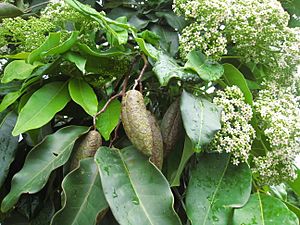Queensland maple facts for kids
Quick facts for kids Queensland maple |
|
|---|---|
 |
|
| Scientific classification | |
| Genus: |
Flindersia
|
| Species: |
brayleyana
|
| Synonyms | |
|
|
The Queensland maple (scientific name: Flindersia brayleyana) is a special tree. It is also known as maple silkwood or red beech. This tree belongs to the Rutaceae family, which also includes citrus fruits. It grows only in northern Queensland, Australia.
Contents
What is the Queensland Maple Like?
The Queensland maple is a tall tree. It can grow up to 35 meters (about 115 feet) high. Its leaves are made up of smaller leaflets, usually six to ten of them. These leaflets are shaped like eggs or ovals. Each leaflet is about 8 to 18.5 centimeters (3 to 7 inches) long and 3 to 8 centimeters (1 to 3 inches) wide. You can see many tiny oil dots on the leaves.
Flowers and Fruit
The flowers of the Queensland maple are white or cream-colored. They grow in groups called panicles, which can be 12 to 23 centimeters (5 to 9 inches) long. After the flowers, the tree produces a smooth, woody fruit. This fruit is like a capsule, about 6 to 10 centimeters (2 to 4 inches) long. When it's ready, the fruit splits into five parts. This releases the seeds, which are about 4.5 to 6 centimeters (1.7 to 2.3 inches) long and have wings to help them fly away.
Where Does the Queensland Maple Grow?
This amazing tree grows in rainforests. You can find it at different heights, from 30 meters (about 100 feet) to 1100 meters (about 3,600 feet) above sea level. Its natural home is between the Daintree River and Rockingham Bay in Queensland.
Is the Queensland Maple Protected?
Yes, the Queensland maple is protected. The Queensland Government considers it of "least concern." This means it is not currently at high risk of disappearing. However, many of these trees are in World Heritage areas. These are special places protected for their natural beauty and importance.
What is the Queensland Maple Used For?
The wood from the Queensland maple is very good quality. It is often used for making beautiful furniture and cabinets. In the past, it was even used to make propellers and plywood for Mosquito bomber aircraft during World War II. It has also been used to make acoustic guitars because of its sound qualities.
However, because many trees are in protected areas, it's hard to get this wood now. There isn't much of it available. People have tried to grow the trees on farms, but it hasn't worked out well so far. The inside wood (heartwood) is pink to brownish-pink. The outer wood (sapwood) is white or light grey.
Images for kids
See also
 In Spanish: Flindersia brayleyana para niños
In Spanish: Flindersia brayleyana para niños



